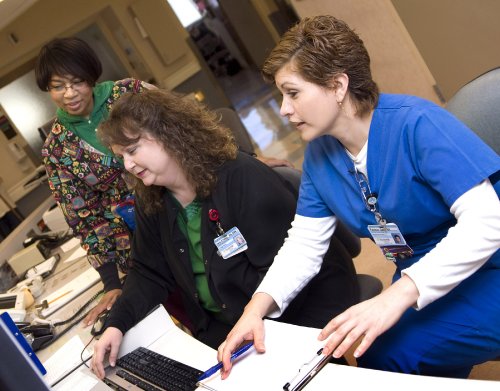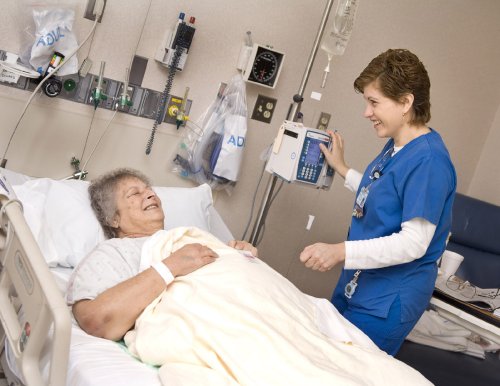
Marayet Warren Francis, R.N., left, Jane Patey, R.N., and Pat Galo, R.N., at the nurses station on the seventh floor of the round wing. (photo by Susan Urmy)
Rounding success for round wing unit
Called “Rounding for a Purpose,” the nursing staff on Medical Center North's seventh-floor round wing has implemented a program increasing their communication and visibility, and as a result, patient satisfaction has soared.
Each hour, a nurse visits every patient to check on his or her needs. During the day's initial rounds, they make sure patients have met their nursing team and their names are written on the white board. They also follow protocol if the patient is a fall risk, monitor the patient's position to prevent pressure ulcers and check if necessary equipment is in the room. Charge nurses lead the effort, but they rotate duties with other nurses and care partners.
“If I had to sum it up in one word, I would say 'proactive.' Instead of waiting on the patient, the nurses are there to head off problems,” said Brent Lemonds, M.S., R.N., administrative director of emergency services and specialty nursing. “Evidence shows a reduction in pressure ulcers, falls and call light use. Because patient needs are being improved, it improves patient satisfaction.”

Pat Galo, R.N., checks in with patient Nancy Frankich. Increased rounding has led to higher patient satisfaction scores. (photo by Susan Urmy)
Since June, when the unit began measuring their rounding efforts, until January, charge nurses have performed 6,389 rounds, averaging about 800 per month. Kaye Stobaugh, R.N., interim manager, said this monthly consistency indicates that the program is hardwired.
In addition to statistical evidence, Stobaugh said she also has a drawer full of thank you notes from patients that testify to the success of the program.
An increased focus on rounding was also important because 7 RW was one of the units that made some patient rooms double occupancy during construction of the Critical Care Tower. The unit has nine double-occupancy rooms, the most at VMC.
“Double occupancy has increased rounding because with two patients we just have to be in there more often, but we also want to keep those patients comfortable,” said charge nurse Jane Patey, R.N.
Patey said rounding is successful because patients often just want some company. For example, when a patient had a request about fixing the TV color, she spent a few minutes talking about favorite shows with him.
Her signature question is “Anything we can do to make things better for you?” and the answer can range from coffee or ice chips to pain medication.
Pat Galo, R.N., focuses on the family in addition to the patient during her rounds.
“Sometimes it's not just the patient that has needs. I see what the family needs because they're very tired, and I see a lot of burnout,” she said. “Sometimes people say 'I'm sorry I'm calling you,' but I say 'That's why we're here. This is our profession of choice.'”
Galo said it was a challenge at first to remind herself to do the rounds, but now she sees how satisfied the patients are.
“Patients feel there is a channel,” she said. “We find out what is needed and share that with the doctor. We are their communicators for what is happening."
"Communication definitely has improved. We rarely have patients say they haven't seen a nurse all day,” Patey added.
Unit managers are also benefiting from the improved communication.
“When we come in, we can ask if we need to see anyone, and it helps us know where to go first,” said Michael Jorden, R.N., manager of 7 RW. “By intervening earlier, we solve many problems faster, and the patient doesn't sit there for hours getting angrier and angrier. They're much more appreciative.”













